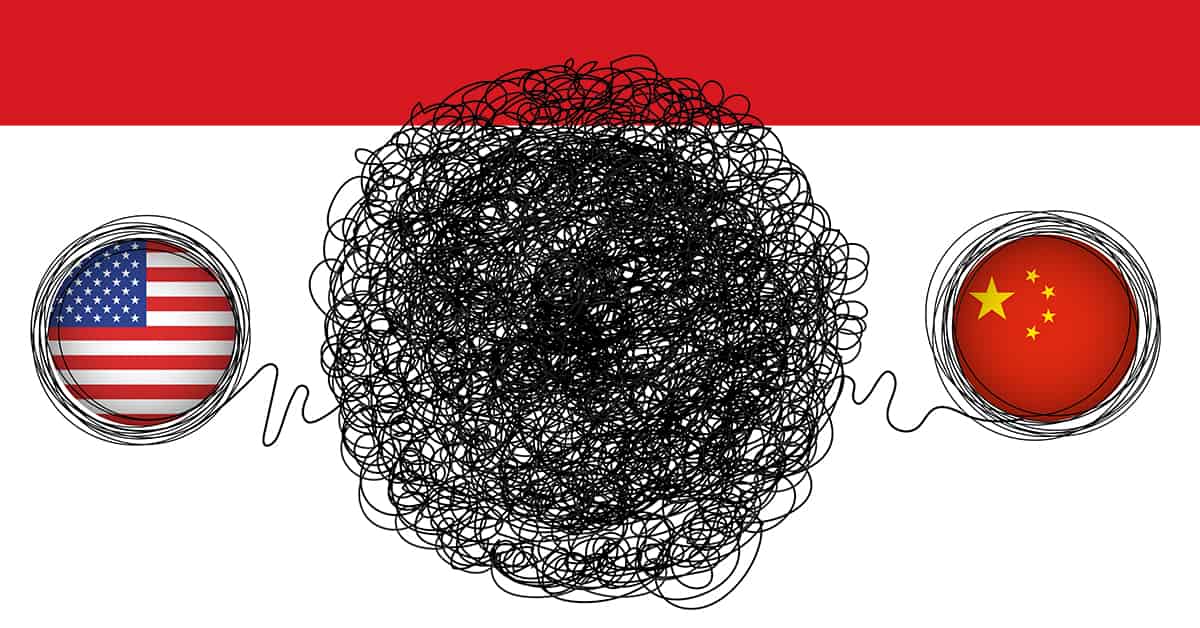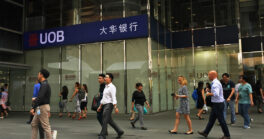Trade between the two countries is at an all-time high, yet signs point to decoupling.

The rhetoric hurled across the Pacific by the US and China has reached fever pitch. In the weeks after the US military shot down an alleged spy balloon in February, Democrats and Republicans in Washington reached a rare consensus: China is a threat that must be contained. China, meanwhile, has warned that the US risks “conflict and confrontation” if it doesn’t change tack, and has repeatedly flexed its military muscles in the waters around Taiwan.
Yet while political animosity has grown, the US and China appear more closely intertwined than ever: Trade in goods between the two reached an unprecedented $690.6 billion in 2022. “The record figures are ostensibly an indication that geopolitical tensions have not harmed business relationships between the two countries,” says Andrew Cainey, founding director of the UK National Committee on China (UKNCC) and co-author of Xiconomics: What China’s Dual Circulation Strategy Means for Global Business.
Even so, Cainey believes the record trade figures are misleading. While US agricultural commodities exports have grown, manufacturing exports are stagnant in aggregate, and technology-intensive exports have fallen. “The outlook for trade and investment flows between the US and China is poor,” he says. It is hard to imagine these two giants could completely disentangle their economies. How far—and how fast—will they separate? And how can global companies successfully navigate the shifting dynamics?
Upping The Ante
Much of the tension between the US and China arose from the speed and scale of China’s growth and the increasing diplomatic might that came with economic power. At first, US businesses welcomed the opening of China’s economy and its promises of cheap labor and new markets. But while China became the world’s largest manufacturing exporter, imports grew more slowly, creating a large trade deficit with the US.
Deborah Elms, executive director of the Asian Trade Centre, argues it was in part China’s objective of greater self-reliance—signaled in the Made in China 2025 strategy—that triggered US tariffs. Announced in 2015, Made in China sought to accelerate the development of technologies such as semiconductors, electric vehicles and biotech to increase the country’s self-reliance. But as China moved up the value chain, many US political and business figures also came to view it more as a competitor than ally, and grew wary of China’s growing assertiveness in global affairs.
In 2018, such concerns led the Trump administration to impose a series of tariffs, specifically protesting China’s alleged lax intellectual property protection and failure to tackle the trade deficit. The unstated, but no less real, goal was to spur US firms to redirect their supply chains away from China, says Elms. China retaliated with tariffs—but also with restraint—targeting goods worth roughly a third of the value of those hit by the US measures.
At first, the US measures had little impact on supply chains, because most firms assumed the tariffs would end under a new administration, says Elms. But the Biden administration retained almost all the Trump tariffs—and added new measures. “With the CHIPS Act, there was a greater emphasis on national security over economic issues,” she says. “The government wants US companies not to rely on China—and to stop China accessing US semiconductors.” The Inflation Reduction Act echoes this strategy: US companies must create domestic green technology supply chains—by implication cutting out China, the world’s leading source of green tech—to access its nearly $400 billion in subsidies.
This mindset is also informing the international engagement of the US, according to Earl Carr, CEO of New York–based CJPA Global Advisors, a global strategy firm which, among other advisory services, helps raise funds for large-scale emerging markets infrastructure projects. “A key requirement from US development-financing institutions is that solar panels must be US-produced, and producers cannot be involved in China’s Belt and Road Initiative,” he says. “That would never have been the case five years ago.”
Meanwhile, such measures prompted Beijing to double down on efforts to reduce China’s dependence, says Elms. The result was the “dual circulation” policy, announced by Xi Jinping in 2020, which marks out a clear distinction between the internal economy (“internal circulation”) and the rest of the world (“external circulation”). “Following an era of ‘opening up’ and integration into the world economy, China now sees greater opportunity at home,” Cainey explains.
Such a shift is both natural and inevitable, given China’s growth—more-mature large economies (like the US) tend to focus more internally. The domestic economy is also where the Chinese Communist Party (CCP) has the most control.
But dual circulation’s focus on national security and self-reliance inevitably plays into the narrative of a more adversarial relationship with the US. Moreover, dual circulation has a second objective. “Xi would like to increase the rest of the world’s dependence on China, both—he says—as a deterrent to economic aggression from the US and—others fear—to increase China’s coercive economic diplomatic power,” explains Cainey. Either way, it signals a clear shift in the way Chinese leaders view their country’s role in global trade.
What Can Companies Do?
For corporates, interpreting a rapidly evolving set of rules—and the words and actions of political leaders—into reworked supply chains and trading relationships is tricky. Corporates in strategic sectors, such as artificial intelligence, quantum computing, biotechnology, advanced semiconductors and anything that could have a dual military/civilian use, are already decoupling, according to Carr at CJPA. “There has been a significant decline in both inbound and outbound investment between the US and China [in these sectors],” he says. “While it’s still continuing in solar and environmental technologies, it is declining.”
US companies in nonstrategic sectors, as part of a broader risk reassessment, appear to be preparing for a future where China plays a less important role, according to Cainey: “They are shifting where they manufacture and source components and intermediate products, based on changing tariffs and trade frictions—and to build in resilience against geopolitical risk.” Part of this is customer driven: Michael Dell, CEO of the eponymous computer group, recently said buyers are pushing Dell Technologies to source components from outside China.
US firms’ major suppliers are also seeking to diversify their supply chains, in consideration of risk management and their buyers’ concerns. For instance, Taiwan’s Foxconn, a major supply partner for Apple, is building out its supply chain in Vietnam, India and elsewhere. “Manufacturers can no longer afford to be motivated solely by short-term costs and just-in-time efficiencies,” says Cainey. “In effect, they are taking out insurance against the increased risks—and insurance costs money.”
Nevertheless, the expense and difficulty of reworking supply chains will limit the scale of change in the near term. “Firms are not going to diversify out of China unless they absolutely have to, because the alternatives are not great,” says the Asian Trade Centre’s Elms. “They might move 5% of their production, but ultimately things are going to be made where they can be done at the right price, to the right quality and according to the right timescale. And at the moment, that’s still China.”
Chinese companies are also on the move, shifting production of solar panels to Vietnam and Malaysia so as to be less vulnerable to trade restrictions, for instance. Indeed, many began to move manufacturing outside China even before the trade conflict with the US, concerned by increasing labor costs and the need to diversify risk. But just as US firms find it tough to match China’s scale advantages when seeking alternative locations, China can offshore only part of its production. “There is a limit to how many suitably skilled managers there are in Vietnam, or the capacity of ports, for instance,” Elms says.
While risk management is the name of the game when it comes to supply chains, the allure of China to US firms remains strong. Tesla, Starbucks and Goldman Sachs all have ambitious expansion plans in the country, for example.
In many sectors, the Chinese government has committed to continue to open up the economy and ensure international firms compete on the same basis as Chinese firms. But equal treatment with Chinese companies may not always be what foreign companies really want. “Under dual circulation, foreign companies need to build up the whole value chain in China, including R&D and manufacturing, and ensure Chinese data is kept in China,” says Cainey at the UKNCC. “It can mean accepting Communist Party organizations within the firm and being responsive to ‘guidance’ from local government and party officials.”
Ram Charan, business consultant to some of the world’s largest corporations, puts it more forcefully. “Every CEO needs to look at the facts, which are observable and verifiable, and be honest about what it means to do business in China,” he says. “You must follow China’s rules and demands, which are in the interests of the CCP and China and require, for example, companies to give up their technology. Every CEO knows this is the case—and if they don’t, all they have to do is call their people in the country and ask.”
Chris Pereira, CEO of the North American Ecosystem Institute, which advises Chinese companies on international expansion, says the US remains a prime market for Chinese companies, despite what he describes as “unfair scrutiny and criticism of Chinese companies by American media and politicians.” He adds, “There is no significant evidence of consumer backlash against Chinese companies.” Indeed, despite the views of US politicians, he says, Chinese firms TikTok and fast-fashion giant Shein remain preferred brands among Generation Z consumers.
But to succeed, Chinese companies need to focus on local compliance, talent and investment—and “de-China” themselves, says Pereira. “There isn’t anything sinister about this—it’s just good business practice,” he says. “The sometimes-awkward attempts at localization by Chinese companies in the US should be encouraged: Companies making these efforts are trying to build bridges across cultures and see the value in diversity.”
Ultimately, Chinese companies operating in the US need to prepare for stormier political weather, however. “The US administration has implemented policies that restrict some exports to China,” notes Charan. “Affected companies need to think about why these rules are being put in place, whether additional restrictions will be implemented and whether a different administration might enact different policies. They need to reevaluate whether their activity in the US continues to create shareholder value. There are no generalities: Every company must look at this for itself and confront the reality.”
A Tightrope Walk
Clearly, the positions adopted by both the US and China will result in less trade and investment between the two countries—that’s part of the objective. Yet, as US Treasury Secretary Janet Yellen recently noted, “A full separation of [the world’s two most important economies] would be disastrous for both countries,” adding that, “It would be destabilizing for the rest of the world.” Keeping the two economies sufficiently connected to avoid harm while satisfying bellicose politicians in both countries is going to be a tightrope walk.
A breakdown in trade relations would not only impact the US and China but also damage the rest of the global economy. The International Monetary Fund estimates that the fragmentation of the world economy into US- and China-centered blocs could reduce global output by as much as 2%, while the president of the European Central Bank, Christine Lagarde, told the Council on Foreign Relations in April that it could hike inflation by “around 5% in the short run and roughly 1% in the long run.”
If Yellen’s worst fears are realized and the global economy divides into polarized camps, the size of the US domestic economy would protect it from the worst of the turmoil. But it’s unclear that the US would emerge as the victor. “With an increasingly closed-off market and heavy restrictions on trade, the US is at risk of isolating itself,” says Pereira. France’s President Emmanuel Macron recently traveled to China with a delegation of 50 business leaders that included the CEOs of Airbus, Alstom and EDF, touting trade. Other erstwhile US allies such as Germany and Saudi Arabia remain keen to forge deeper trade and investment links with China.
At the same time, the US enacted a new forced-labor rule banning the import of cotton from China’s Xinjiang region, where it is alleged that Uyghur people are being subjected to forced labor. This could push Asian companies—many of which currently trade heavily with both China and the US—more firmly into China’s orbit. “As the rules require companies to prove that they are innocent, they are extremely hard to comply with,” says Elms. “If that approach is adopted more widely, and exporters to the US are required to prove that no components come from a blacklisted company, it could force many to reconsider their business model.”
The implementation and ramifications of these new policies will emerge over time, creating new economic structures and dynamics. UKNCC’s Cainey “‘Decoupling’ is a slippery, hard-to-define word,” says UKNCC’s Cainey. “But the weakening and change in commercial relationships is real.”



